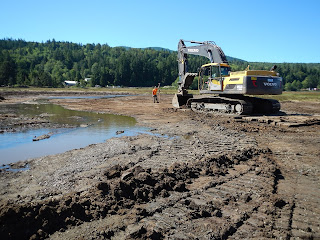Railroad trestles that once carried rail traffic from Port Townsend to Port Angeles are removed in Discovery Bay as part of the Discovery Bay Estuary Restoration Project
NOSC has worked closely with the Washington Department of Archaeology and Historic Preservation to remove the railroad bridge trestles along the Maynard shoreline, and over Snow and Salmon Creeks. NOSC strongly values the history of this site and will be installing interpretive signage to commemorate the cultural heritage of this area.
The Discovery Bay railroad bridges were removed due to the presence of creosote on the pilings. Creosote has been used as a wood preservative for a century to treat telephone poles, railroad ties, piers, docks and floats. There are thousands of derelict creosote pilings in Puget Sound that eventually fall apart, drift around the Sound, and wash ashore, leaving tons of toxic wood debris on beaches throughout the Sound.
 |
| Removal of the Maynard Bridge |
Creosote is composed of more than 300 chemicals that, together, are very effective at achieving their intended purpose: preventing decay and infestation. However, when these chemicals leach into the Sound they can harm other organisms as well. A piling that contains creosote can leach throughout its entire lifetime.
 |
| Removal of the Salmon Creek Bridge |
Chemicals in treated wood—such as those on beaches or old dock pilings—can be harmful and even toxic to marine species. Polycyclic aromatic hydrocarbons (PAHs) are the chemicals of most concern. Recent studies have shown that PAHs are detrimental to salmon immune function and development. Other studies have shown that herring eggs exposed to creosote have a high mortality rate and English sole develop liver lesions. These and other affected species are important in the food chain for salmon, Orca whales, and birds.
The railroad trestles were removed with funding from the Washington Department of Natural Resources and work is being conducted by Seton Construction Co. of Port Townsend.



























